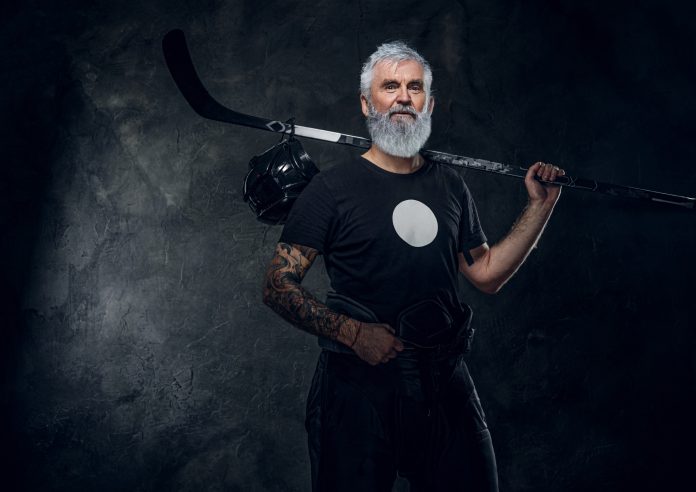Hockey is a sport that captures the hearts of individuals of all ages, and seniors are no exception. The thrill of gliding on the ice, the team’s camaraderie, and the game’s pure joy can be a lifelong passion. However, as we age, our bodies undergo changes that may make us more susceptible to injuries on the ice. This comprehensive guide will explore essential tips for senior hockey players to prevent injuries and continue enjoying the game they love.
Understanding the Unique Challenges
A. Age-Related Factors Affecting Senior Players
Senior hockey players face unique challenges due to the aging process. It’s essential to recognize these factors and tailor injury prevention strategies accordingly.
- Decreased Flexibility and Muscle Mass
- As we age, our flexibility tends to decrease, making it essential to focus on maintaining and improving range of motion.
- Loss of muscle mass and strength can affect balance and stability on the ice.
2. Slower Reaction Times
- Reaction times naturally slow down with age, impacting the ability to respond quickly to changing situations during a game.
- Recognizing the need to adapt playing style to accommodate these changes is crucial.
B. Recognizing the Importance of Tailored Injury Prevention Strategies
Acknowledging these age-related factors is the first step in creating an injury prevention plan that addresses the specific needs of senior hockey players.
Proper Equipment and Gear
A. Ensuring a Perfect Fit for Your Protective Gear
Properly fitting protective gear is vital for injury prevention. Seniors should regularly check their equipment to ensure it fits correctly, especially if they have experienced weight or muscle mass changes.
B. The Role of Modern Equipment in Injury Prevention
Advancements in hockey gear have led to increased safety on the ice. Seniors should consider investing in modern equipment that offers enhanced protection without compromising comfort.
C. Tips for Selecting the Right Helmet, Padding, and Skates
- Pick one with extra safety features like impact protection and an adjustable fit for helmets.
- Make sure your shoulder pads, elbow pads, and shin guards keep you safe without limiting your movement.
- When choosing skates, go for ones that support your ankles and feel comfortable. Also, ensure the blades are sharp to help you stay steady on the ice.
Warm-Up and Stretching
A. The Significance of Warming Up Before Hitting the Ice
Warming up before practice or a game is essential for seniors to prepare their muscles and joints for physical activity. A proper warm-up increases blood flow, loosens muscles, and reduces the risk of injury.
B. Dynamic Stretching Routines for Senior Players
Dynamic stretching involves active movements that mimic the motions you’ll use during your game. Senior players should incorporate dynamic stretching into their warm-up routine to improve flexibility and mobility.
C. The Benefits of Incorporating Yoga and Mobility Exercises
Yoga and gentle exercises can help senior hockey players by making them more flexible, balanced, and aware of their bodies. Consider adding these exercises to your off-ice routine to play better and lower your risk of getting hurt.
Strength and Conditioning
A. Tailoring Strength Training for Seniors
Strength training is crucial for senior hockey players to maintain muscle mass, joint stability, and overall strength. However, it’s essential to tailor strength training programs to suit the needs and abilities of older individuals.
1. Muscle and Joint Strength
- Focus on exercises that target major muscle groups and joints involved in hockey movements, such as squats, lunges, and resistance band exercises.
- Gradually increase weights and resistance levels as strength improves.
- Improving Balance and Stability
- Balance exercises, such as standing on one leg or using a balance board, can help seniors improve their stability on the ice.
- Enhanced balance can reduce the risk of falls and related injuries.
B. Low-Impact Exercises for Off-Ice Conditioning
Low-impact exercises like swimming, stationary cycling, and elliptical training can provide cardiovascular conditioning without putting excessive stress on joints. Incorporating these activities into your fitness routine can help maintain overall conditioning.
C. Staying Active and Maintaining Fitness During the Off-Season
It’s essential for senior hockey players to stay active year-round, even during the off-season. Regular physical activity will help maintain strength, endurance, and overall fitness, reducing the risk of injury when returning to the ice.
On-Ice Techniques
A. Focusing on Proper Skating and Puck-Handling Techniques
Senior players should prioritize proper skating and puck-handling techniques to minimize the risk of most common hockey injuries caused by awkward movements or collisions.
B. Reducing the Risk of Collisions and Falls
- Positioning: Learn to read the game and position yourself effectively to avoid high-impact collisions.
- Agility Training: Practice agility drills to improve your ability to change direction quickly and avoid collisions.
- Controlled Contact: When contact is unavoidable, focus on controlled and safe contact to minimize the risk of injury.
C. The Importance of Communication and Teamwork
Effective communication on the ice is essential for avoiding collisions and injuries. Seniors should communicate with teammates about their positioning and intentions during games to prevent accidental collisions.
Nutrition and Hydration
A. Fueling Your Body for Optimal Performance
Proper nutrition is crucial for seniors to maintain energy levels and support their physical activity. A well-balanced diet should include a mix of carbohydrates, protein, healthy fats, and plenty of fruits and vegetables.
B. Hydration Strategies for Senior Players
Seniors are more susceptible to dehydration, leading to muscle cramps and decreased performance. Hydration should be a priority before, during, and after games and practices. Carry a water bottle and sip regularly to stay adequately hydrated.
C. Supplements and Vitamins That Can Aid in Injury Prevention
Consult with a healthcare professional to determine if supplements, such as calcium, vitamin D, or joint-supporting supplements, may benefit your specific needs. Nutritional supplements can help support joint health and overall well-being.
Rest and Recovery
A. Recognizing the Need for Adequate Rest
Rest is essential for seniors to recover and allow their bodies to heal between games and practices. Avoid overtraining, and listen to your body’s signals of fatigue.
B. The Role of Sleep in Injury Prevention
Quality sleep is vital for recovery and injury prevention. Aim for 7-9 hours of restorative sleep each night to support muscle repair and overall physical and mental health.
C. Techniques for Managing Post-Game Soreness
After games or intense practices, seniors should implement recovery strategies such as ice baths, foam rolling, and gentle stretching to alleviate muscle soreness and promote faster healing.
Recognizing Early Warning Signs
A, Being in Tune with Your Body
Senior players should pay close attention to their bodies and proactively address any signs of discomfort, pain, or reduced performance. Early intervention is key to preventing more severe injuries.
B. Common Signs of Potential Injuries in Senior Players
- Persistent pain in joints, muscles, or ligaments
- Swelling or inflammation that doesn’t subside
- Decreased range of motion or flexibility
- Unexplained fatigue or weakness
- Difficulty with balance and coordination
- Hockey wrist injury or pain after playing
C. When to Seek Professional Medical Advice
If you experience any of the above signs or suspect an injury, consult with a healthcare professional or sports medicine specialist promptly. Early diagnosis and appropriate treatment can prevent injuries from worsening.
Coaching and Support
A. The Value of Experienced Coaches
Seeking guidance from experienced coaches who understand the unique needs of senior players can be invaluable. Coaches can provide tailored training and support to maximize performance while minimizing the risk of injuries.
B. Building a Supportive Team Environment
It is essential to foster a supportive team environment where senior players can communicate openly about their concerns, needs, and injuries. Teammates and coaches should encourage a culture of safety and mutual support.
C. Encouraging Open Communication About Injuries and Concerns
Seniors should feel comfortable communicating with their coaches and teammates about any injuries or discomfort they experience. Promptly reporting injuries and seeking support ensures that necessary precautions can be taken.
Mental Resilience
A. Overcoming the Fear of Injury
Fear of injury can be a psychological barrier for senior players. Addressing and overcoming these fears is essential to play confidently and without hesitation.
B. Staying Motivated and Positive Despite Age-Related Challenges
Maintaining a positive mindset and motivation to play despite age-related challenges is crucial. Focus on the joy and camaraderie that hockey brings, and view challenges as opportunities for growth.
C. Coping with Setbacks and Injuries
Injuries are a part of any sport, but they should not deter senior players from enjoying hockey. Developing resilience and coping strategies for setbacks can help you bounce back stronger.
Conclusion
In conclusion, age should never be a barrier to enjoying the sport of hockey. By understanding the unique challenges and needs of senior players and by implementing the tips discussed in this guide, you can continue to thrive on the ice while minimizing the risk of injuries.
Remember that safety and injury prevention are paramount, as are the love and passion for the game. Prioritize your well-being, stay active, and embrace the joy of playing hockey for years to come. Whether you’re a seasoned senior player or considering picking up the sport later in life, the ice is always waiting for you to glide across it.























